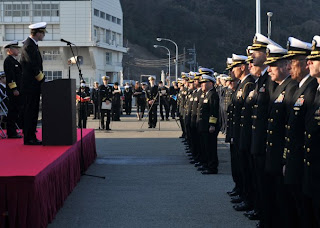January 19, 1960. I was in 8th grade at St. Gregory's School in Phoenix, AZ, where I had somehow struggled my way into the starting five of our basketball team. I was "going with" one 8th grade girl while at the same time infatuated with another girl who was "going with" one of the stars of the basketball team, who was much better at the game than I was. Approaching the end of my 14th year on earth, my life's priorities revolved around classroom and gym, studies and dances, sports and girls. I knew little of the world beyond St. Gregory's, Phoenix, or Arizona...and I cared even less.
I was blissfully unaware that on that very day President Dwight D. Eisenhower and Japanese Prime Minister Nobusuke Kishi signed the Treaty of Mutual Cooperation and Security between the United States and Japan. So I had not the slightest inkling that 50 years later I would be wearing U.S. Navy service dress blues while standing at attention on a pier in Yokosuka, Japan at a ceremony honoring that very event.
In 1960 all I knew of Japan and its military was what I'd seen in the epic film, "Bridge on the River Kwai" or similar movies (most of which featured John Wayne). If anyone had told me then that I would eventually count among my friends some high ranking Japanese admirals I would have probably given you the same incredulous look I sometimes get from my son when I suggest things beyond his ken. But such is the challenge of youth, not knowing how much you really don't know.
 The simple yet profound ceremony was hosted by the Japanese Maritime Self Defense Force (JMSDF), or Kaijou Jieitai in Japanese. Officers and enlisted from both nations stood in ranks for speeches by the U.S. 7th Fleet Commander and his Japanese counterpart, the Commander in Chief, Self Defense Fleet. We then honored the raising of both nation's colors aboard the JMSDF Takanami-class guided-missile destroyer JDS Oonami (DD 111) and the U.S. Arleigh Burke-class guided-missile destroyer USS Lassen (DDG 82). To me the most profound moment of the ceremony was when the bands from each fleet flawlessly and beautifully played each other's national anthems.
The simple yet profound ceremony was hosted by the Japanese Maritime Self Defense Force (JMSDF), or Kaijou Jieitai in Japanese. Officers and enlisted from both nations stood in ranks for speeches by the U.S. 7th Fleet Commander and his Japanese counterpart, the Commander in Chief, Self Defense Fleet. We then honored the raising of both nation's colors aboard the JMSDF Takanami-class guided-missile destroyer JDS Oonami (DD 111) and the U.S. Arleigh Burke-class guided-missile destroyer USS Lassen (DDG 82). To me the most profound moment of the ceremony was when the bands from each fleet flawlessly and beautifully played each other's national anthems.While I have matured over fifty years from that testosterone-driven nacent teenager of 1960, the U.S.-Japan alliance has grown into one of the most powerful and meaningful alliances in the world today. Just as the lives of Americans are inexorably linked to Japanese companies such as Sony, Yamaha, Panasonic, and Toyota, the main street of Yokosuka is dotted with the likes of KFC, Burger King, TGI Fridays, and a department store owned by Wal-Mart. But the alliance is far more than financial or political. It is rooted in deeply held principles and fundamental beliefs about freedom and honor and courage and integrity. So while our cultures may be different in many ways, we are closely allied by very similar core values. And, for those of us who wear uniforms that are likewise different yet similar, a deeper tie exists: our honorable commitment to serve, and to defend those shared core values against a spectrum of potential enemies.
In January, 1960 that 13-year-old boy certainly had no idea where his life would be 50 years later. I really don't remember ever having a plan for that far in the future, but I can think of no higher honor than to be standing on that pier, wearing that uniform, in a country that my family and I have come to love, with a people whom we are honored to regard as friends, and sharing colors and national anthems with my brothers and sisters of the Kaijou Jieitai. A glorious day indeed.

1 comment:
Very interesting Mike. But, what happened to the 2 girls??
JWIII
Post a Comment